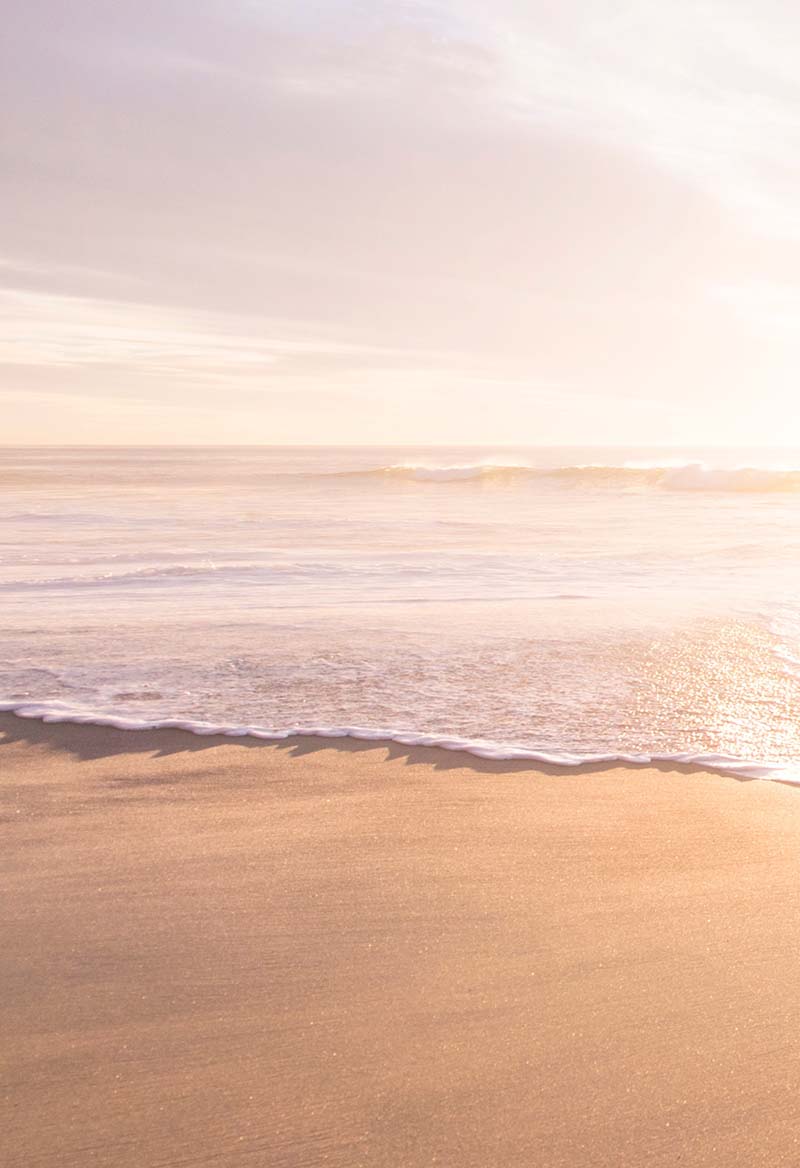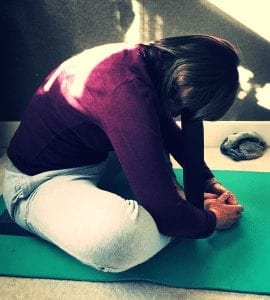Ocean breathing is a beautiful way to feel calm and relaxed.
The Sound of Waves on a Beach
I love the sound of waves on a beach. The gentle breath of the sea is constant, rising and falling in an eternal rhythm. It makes me feel quiet and secure.
I think part of the reason we find wave sounds so calming is because they correspond to the natural inhalation and exhalation of our breathing. Our own flowing life is echoed back to us.
Ujjayi Breath
Ujjayi breath is a breathing practice often used in Yoga. The Sanskrit name means “Victorious breath”. It is so called because the practice helps build positive control over both body and mind, leading to inner calm. This way of breathing is also known as “Ocean breath” because it sounds like the sea[i].
Benefits of Controlling the Breath
Ocean breath or Ujjayi breath involves a slight restriction at the back of the throat, together with steady and regular inhalations and exhalations. You breathe through the nose, keeping the mouth softly closed. In this way the breath is controlled.
The effects are very calming and steadying. Ocean breath is coupled with sequences of poses in Ashtanga or Vinyasa Yoga classes to help create focused and mindful movement. But it is also a hugely beneficial practice on its own, or with meditation.
Ocean breathing slows down the breath and encourages you to focus your mind on your breathing. When we slow our breath, our heartbeat slows down too, and the body begins to settle into the calm “rest and digest” state.
The Vagus Nerve
The vagus nerve is the key to unlocking your calm parasympathetic nervous system. This important nerve passes through the neck. It is affected by the throat constriction and steady breath pattern when you practice Ocean breathing. That means this Ocean breath is a reliable way to manage anxiety and panic attacks. You will quickly feel relaxed and calm.
Long Term Health
Like all practices that help us enter the calm parasympathetic state, Ocean breathing is good for long term health. By settling the mind and relaxing the body, it is helpful in managing and preventing all those conditions related to inflammation and stress. These include bowel conditions, cancers, heart disease, depression, diabetes and high blood pressure.
Focus and Concentration
Regular breath practices are helpful for focus and concentration. This is because you are learning to settle your busy mind. If you are easily distracted or forgetful, or when you have an important task to complete, Ocean breathing can you focus. You can work more efficiently and get more done.
Meditation and Visualisation
Ocean breathing works well on its own or as a background to a visual meditation. I like to visualise waves on the seashore as I breathe. If you are lucky enough to be able to visit a beach, you can try watching the waves and breathing with them.
How to do the Ocean Breath
Sit Comfortably and Upright
You need to sit upright for this one. Sit on a cushion on the floor, or on an upright chair. Make sure you are comfortable, and your hips are higher than your knees. If you are on a chair, your feet should be resting flat on the floor.
Relax your shoulders and grow tall through your spine. Try to make sure your core muscles are supporting your lower back.
Now drop your chin slightly downwards towards your chest.
Try breathing through out through your mouth first
To practice making the ocean sound in your throat, imagine you are breathing on a mirror and you want to make mist on it with your breath. Breathe out gently through your mouth making a soft “haaaaaa” sound. Visualise the mirror steaming up. Do this a few times. Notice how this breath feels in your throat.
Now Breathe through your Nose
Now close your mouth and breath in and out through your nose. Try to make the same soft “haaaaa” sound at the back of your throat. Some people say this sounds a bit like Darth Vader! I prefer to think about waves on the shore, or the sound a seashell makes when you hold it up to your ear.
The sound and the feeling should be soft and gentle, like a whisper. It should not feel uncomfortable in your throat, but there should be a slight feeling of constriction.
Keep Breathing Regularly
Keep breathing in and out like this, using your nose to breath, and making that gentle whispering sound inside your throat. See if you can imagine the waves on the sea on a lovely sunny day as you inhale and exhale.
To help yourself breathe steadily, you might like to count in your head. You can count 1-2-3-4 as you breathe in, and then 1-2-3-4 as you breathe out. If it feels right, you can count up to five or six. Don’t try to hold your breath or breathe in or out for longer than is comfortable. You are aiming for an easy, steady rhythm.
Using Sounds to Regulate the Breath
Some people like to use timed sounds to help calm and regulate their breathing. I like an app called Breathe Plus which offers a range of different rhythms coupled with soothing sounds.
https://apps.apple.com/us/app/breathe-simple-breath-trainer/id1106998959
You can set it to the speed which suits you, and it also incorporates a timer, which I find useful. There are several similar apps on offer, so experiment with what works for you.
Other Breathing Patterns
For Ujjayi breath/Ocean breath, you usually stick to a balanced rhythm where you breathe in and out for the same amount of time. However there are other counted breath patterns which are also worth trying. It can be very relaxing to breathe out for a longer time than you breathe in. This is useful if you are feeling agitated as it slows down the breath and prevents hyperventilation. I teach this in my Pregnancy Yoga classes as it is especially helpful for labour and birth.
Today’s Calming Practice
Today, find somewhere quiet to sit and try Ocean breathing. Visualise the gentle waves lapping on the shore. Breathe calmly and relax.
Thanks for reading this blog post. I am writing a series of 31 blogs every day this August. I plan to publish them later in the year as a book entitled, ‘Finding Your Calm Space – 31 Ways to Find Calm in a Crazy World’.
CLICK HERE TO DOWNLOAD A FREE GUIDED BREATH COUNTING MEDITATION VIDEO
I’m Karen. I am a Yoga teacher, Reflexologist and busy mum of seven. I live with my family in Billericay, Essex, UK. In the past I have worked as a Midwife, Health Visitor, Baby Signing teacher and Tax Inspector. I love getting outdoors, swimming in the sea, walking and writing. Helping people relax is one of the things I do best.
You can learn more about my Yoga classes and Reflexology at my website www.thecalmspace.co.uk
[i] https://www.ekhartyoga.com/articles/practice/a-guide-to-ujjayi-breath





I loved reading this breathing post. I’ve attended many yoga classes, but having each type of breath described this way really helped it all click. I’m going to try Ocean breathing today next to the ocean 🙂
Thanks Rebecca. So glad you found it helpful. xx